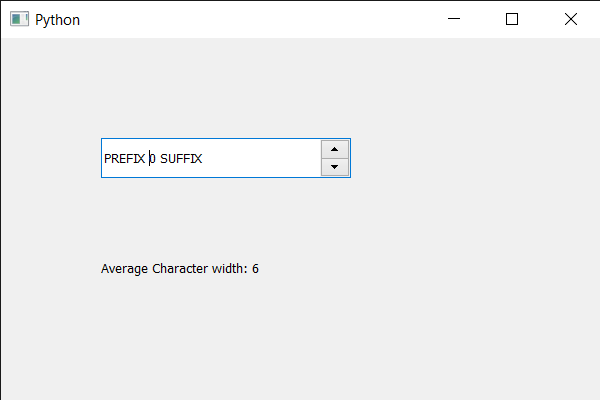PyQt5 QSpinBox – 获取字体的升序
在这篇文章中,我们将看到如何获得旋转盒子的字体(即文本)的上升空间。字体的上升是指从基线到字符延伸到的最高位置的距离。在实践中,一些字体设计者打破了这一规则,例如,当他们在一个字符的顶部加上多个重音时,或者为了适应异国语言中的一个不寻常的字符,所以这个值有可能(尽管很少)太小。
为了做到这一点,我们用旋转箱的QFontMetrics对象的上升方法。
语法: font_metrics.ascents()
参数: 它不需要参数
返回: 它返回整数
下面是实现方法
# importing libraries
from PyQt5.QtWidgets import *
from PyQt5 import QtCore, QtGui
from PyQt5.QtGui import *
from PyQt5.QtCore import *
import sys
class Window(QMainWindow):
def __init__(self):
super().__init__()
# setting title
self.setWindowTitle("Python ")
# setting geometry
self.setGeometry(100, 100, 600, 400)
# calling method
self.UiComponents()
# showing all the widgets
self.show()
# method for widgets
def UiComponents(self):
# creating spin box
self.spin = QSpinBox(self)
# setting geometry to spin box
self.spin.setGeometry(100, 100, 250, 40)
# setting range to the spin box
self.spin.setRange(0, 999999)
# setting prefix to spin
self.spin.setPrefix("PREFIX ")
# setting suffix to spin
self.spin.setSuffix(" SUFFIX")
# creating a label
label = QLabel(self)
# making label multi line
label.setWordWrap(True)
# setting geometry to the label
label.setGeometry(100, 200, 300, 60)
# getting font metrics
f_metrics = self.spin.fontMetrics()
# getting ascent
ascent = f_metrics.ascent()
# setting text to the label
label.setText("Ascent : " + str(ascent))
# create pyqt5 app
App = QApplication(sys.argv)
# create the instance of our Window
window = Window()
# start the app
sys.exit(App.exec())
输出:

 极客教程
极客教程